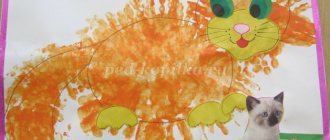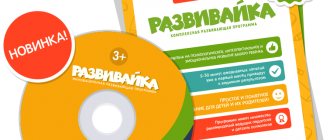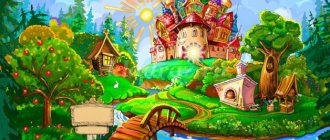Open theatrical lesson in the middle group
Summary of a lesson in theatrical activities in the middle group “Playing theatre.” During the lesson, the teacher must discover the talent of each child, develop their creative abilities through theatrical activities. Children in the middle group must learn to correctly pronounce the text, expressing their emotions. To perform the work, special equipment is prepared:
- cards-drawings with a person’s facial expression;
- kitten toy;
- laptop;
- recording music.
Preparation and conduct of classes in preschool educational institutions
Theatrical activities in the middle group of preschool educational institutions are an exciting process for children. To attract the child's interest in this activity, you need to come up with a fun game. For example, a teacher brings with him a beautiful chest that was found on the way to kindergarten. This chest contains fairy tale characters. In order for the item to open, the guys must guess the riddle.
Patriotic education in preschool educational institutions
Another scenario is choosing a fun outfit. To interest children in theatrical activities, the teacher can choose the outfit of a grandmother-storyteller (Malanya or Arina). The teacher invites preschoolers to play with her.
Lesson plan
To conduct the lesson, a special long-term plan is drawn up. The idea of different types of theater is consolidated. Techniques for working with finger theater are also reinforced. The director's approach is an examination of interesting games “The Hare Had a Garden”, “Farewell to Winter”, “Meeting Spring”, during which preschoolers develop an interest in the performing arts.
Lesson planning
Important! This helps to develop goodwill and communication skills in relationships with each other.
In addition, the teacher conducts a conversation with the children while reading a fairy tale. This stimulates emotional perception. Thus, the vocabulary is replenished. Preschoolers learn to find expressive means in facial expressions.
Stage attributes
Before conducting a lesson, the teacher must prepare stage attributes (accessories, hats, scenery), such as dolls, theatrical costumes, and makeup.
Applying Stage Attributes
Example scripts
The teacher tries on the image of a storyteller who conducts a fascinating conversation with children. The children are invited to impersonate the images of the artists - learn to convey feelings through facial expressions and gestures.
Example scripts
A special theatrical project is being created in a playful form. Children must convey specific emotions to each other. The next task is to pass a certain number of claps in a circle. You need to pronounce the phrase “Let's go, let's go to the forest for nuts.”
The storyteller tells the preschoolers that a kitten has come to visit them. Children remember cartoons and fairy tales in which this hero is present, and then pass the toy kitten to each other.
The teacher reads the poem by B. Zakhoder “Kiskino Grief” or K.I. Chukovsky “Aibolit”.
An open lesson with children on GCD - a conversation is held on the content. Some children tell it sadly, others cheerfully.
The teacher invites the children to turn into a kitten who wants to steal sausages. You need to get up from the chair, like a pussy, on your hind legs, spin around the table, inhale the fragrant smell of sausages. But then the owner comes in and the kitten runs away.
Reading a poem by L. P. Savina:
“Pussy, pussy, pussy!
Julia called the kitten.
Don't rush, wait, wait!
And she stroked it with her hand.”
The children are asked to imagine how they are stroking a cat with their hand.
It's time for the storyteller to return home. She asks the guys what they liked most about the lesson, what interesting things they learned.
MAGAZINE Preschooler.RF
Theatrical kaleidoscope. Musical lesson in the junior and middle groups “Journey to the magical world of theater”Target:
- To form children's understanding of theatrical art.
Tasks:
- Support children's desire to actively participate in entertainment, using the skills acquired in classes and in independent activities.
- Encourage them to independently search for expressive means (gestures, movements, facial expressions) to create an artistic image.
- To cultivate a desire to control theatrical puppets of different systems. Improve children's artistic skills.
Equipment: hats and pictures of a fox and a hare, presentation “Theater” , gnome, steering wheel for the bus.
Form O.D “Excursion to the theater”
Children enter the hall to the music.
Musical director: Children, our good friend the gnome Tin Don invites us today on the way to visit the little people to stop by the children's theater. And he also wants to see if our children today can become real theater artists. Do you want to visit the theater?
How will we go to the theater? (children's answers) You can go to the theater using any type of transport, but I suggest you remember a song with which we can quickly get to the theater.
“We are going, going, going... (children with a gnome are driving around the hall)
Slide: Theater.
Musical director: We sang the song so friendly and cheerfully that we didn’t even notice how we arrived. Look how beautiful the theater building is!
The bell rings
Musical director: Oh guys, do you hear? This is the first bell - it's time to take your seats in the auditorium. Children sit on chairs in front of the screen.
Slide: Scene.
Musical director: Notice how beautiful the scene is. And what do you think? Who is the most important person in the theater? The stage manager, the director, watches everything with an eagle eye. The director, having learned that we were from kindergarten, decided that we should also be artists.
Music Director: It takes a lot of work to become such great artists. (Wags his finger). Guys, what did I just show you? That's right, I made a gesture. In order for an artist to express the character of his character, he needs gestures.
Dwarf: So, any movements of parts of the face, eyebrows, eyes - what are they called? (Mimic expressions). I would like to invite you guys to a theater workshop. Let's try to convey the mood of the clouds with facial expressions.
Mimic exercise “Clouds” Children show with facial expressions.
Musical director:
Clouds floated across the sky, and I looked at them. And I wanted to find two similar clouds. Here is a cheerful cloud laughing at me.
Why are you squinting your eyes like that? How funny you are! But another cloud was seriously upset:
The breeze suddenly carried him far away from his mother. And suddenly a menacing Scarecrow flies across the sky with a huge fist
He threatens me angrily. And a small cloud floats above the lake. And a cloud of surprise
Opens his mouth slightly.
Gnome: You did a very good job of conveying the mood of the clouds. Well done, you are real artists!
Music hands Well, friends, these are our costumes (takes out the hats of the heroes of the fairy tale “The Fox and the Hare” . (pictures of the fox and the hare)
Listening to the songs “Bunny No. 1” , “Fox No. 2” Character. Showing movements characteristic of animals.
Warm-up “Little Fox No. 2”
Learning the song “Bunnies No. 3”
Bunnies scattered across the forest lawn. These are the bunnies, runaway bunnies! The bunnies sat in a circle, digging a root with their paws. These are the bunnies, runaway bunnies!
Suddenly a fox runs - her red sister. Looking for where the bunnies are, the Runaway Bunnies?
Musical game "Bunny No. 3"
Guys, did you enjoy the theater today? What did you like most?
Children, singing the song “We are going, we are going...” leave for kindergarten.
Summary lesson on theatrical activities in the senior group
Topic: "Theater"
Tasks:
Support children's desire to actively participate in entertainment, using the skills acquired in classes and in independent activities.
Encourage them to independently search for expressive means (gestures, movements, facial expressions) to create an artistic image.
To cultivate a desire to control theatrical puppets of different systems. Improve children's artistic skills.
Materials and equipment for the lesson:
Emotion cube, presentation, fox hat.
Form OD Journey into the magical world of theater"
Mysterious music sounds.
The teacher brings the children to the music room. Children in a circle perform a greeting ritual. “Let’s say hello musically” by singing your name.
- Guys, it’s no coincidence that we say hello like this today, today I invite you to take a trip to an unusual, fairy-tale country, to a country where miracles and transformations happen, where dolls come to life and animals begin to speak. Have you guessed what country this is?
Children: - THEATER!
– Do you know who lives in this country?
Children: - Dolls, fairy-tale characters, artists.
- Yes, guys. You said it right. Do you know what artists do? (Children's answers)
– Would you like to become an artist?
– I have a magic wand and now with its help I will turn you all into artists. Close all your eyes, I say the magic words:
-One, two, three - turn around
And turn into an artist!
Open your eyes. Now you are all artists. I invite you to enter the wonderful world of theater!
Ahead, the children see a cube with emotions...
Game "Guess the Emotion"
The box goes around in a circle while the music plays. Then the child makes facial expressions, names it, and everything is depicted on his face.
– When do we have a joyful mood?
– When we are having fun, when they give us something, etc. (Children's answers).
- Well done boys. Let's put the emotions back in the box and continue on our way.
Children sit on chairs
That's how you and I came to the theater.
Presentation.
Slide: Theater.
Musical director: Look how beautiful the theater building is!
Slide: Scene.
Musical director: Notice how beautiful the scene is. And what do you think? Who is the most important person in the theater? The stage manager, the director, watches everything with an eagle eye. The director found out that we have turned into artists and suggests defining the genre of music that is played in theaters.
“Define the musical genre” (music 3, 5)
Listening to fragments of a polka, waltz, minuet.
Describe the music. Show moves on the big stage.
The April 1 holiday is coming soon and we will be artists, we will perform in front of kindergarten children.
Physical exercise “Lisonka”
Preparatory group Learning the song “A young horse galloped into the field”
Senior group. The girls sing the verses of “Spring Drops” , the boys sing along with the chorus...
| Next > |





